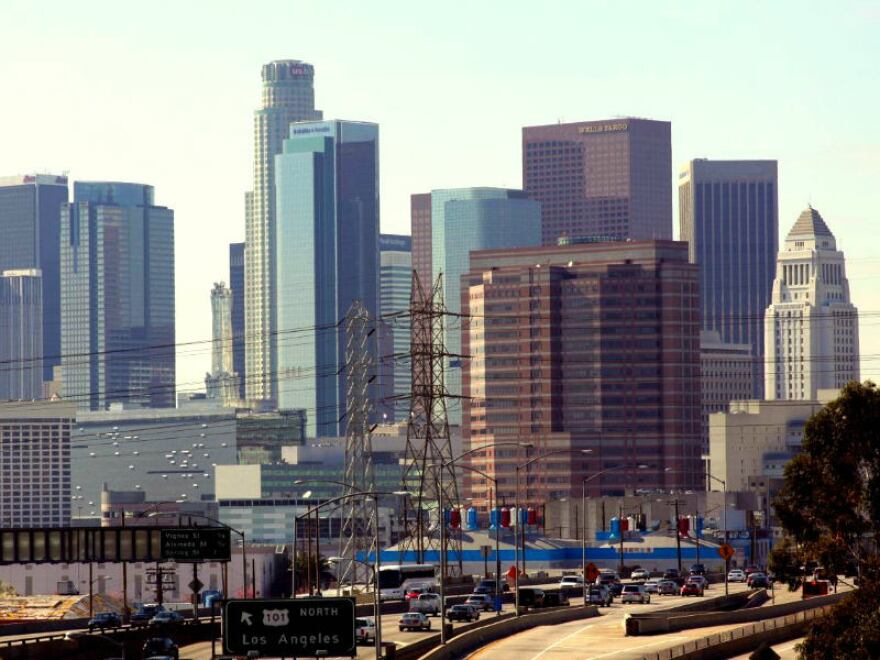Some scientists say we don’t have to go back to having such poor air quality in the state, but they recognize it will take a total mindset change for Californians. The number of miles driven in the state has dropped by around 75% since stay-at-home orders went into place and has resulted in a significant reduction in greenhouse gas emissions, said UC Davis Road Ecology Center director Fraser Shilling.
“We're learning new things about our driving behavior … can we both mitigate the harm from COVID-19 and also mitigate the harm that we cause by burning fuel and causing climate change?” Sterling questioned after analyzing data from Streelight.com.
Nationally he reports there was a reduction of around 74 billion miles traveled in the U.S. from early March to mid-April. That resulted in a greenhouse gas emissions reduction of 4% nationally for 2020 and by 13% from transportation in about eight weeks.
If this continues, Shilling says, the reduction of miles traveled could drastically impact our climate goals for the better, including putting the nation on track to meet its annual greenhouse gas reduction goals under the Paris Climate Accord.
He says it’s an interesting position for the federal government to be in where the lack of driving allows the U.S. to meet the goals of the “Paris Climate Accord, and on the other hand, inadvertently exceed the goals ... It's a cool green lining.”
California has a 2050 goal of reducing greenhouse gas emissions by 80% from 1990 levels. Shilling says if traffic remained at stay-at-home levels for a year, the drop in miles traveled would allow the state to meet half of its climate target by 2050.
The rest of the reductions would come from all sectors of the economy including transitions to bioenergy, offshore wind power, and increased energy storage. A 2019 study highlighted by Stanford University from the group Energy Futures Initiative says meeting the 2050 goals will be “extremely challenging.”
“It's painful to drive less and have less economic activity,” Shilling said. “But when we drive less, and when we work at home, we can start to meet these climate change goals. They're not so far out of the way, out of bounds that we can't achieve them.”
But Shilling says there are negative aspects, depending on how you look at it, including potentially $370 million less state fuel tax revenue.
“The upside for drivers — like I filled my tank a month and a half ago — is we're not spending as much on fuel,” Shilling said. “The less fuel that's sold, the less fuel tax revenue … that money is not available for transportation projects.”
Could California keep its cleaner air?
Researchers at UCLA are taking this idea further. A study came out this week saying that California has all the policies and technology to stop all human-caused emissions by 2050.
“We think there is a room for California to achieve that goal ahead of the game,” said Yifang Zhu, one of the authors of the peer-reviewed study published in the journal Nature Sustainability.
The authors call for increased energy efficiency across all sectors and reducing emissions from energy creation as the core ways to reach the sped up goal. That would mean a “systematic change” in how Californians consume energy and “more stringent” policies.
“We're talking about 85% electrification rate in the residential and commercial sectors, which we’re not even close to [today],” Zhu said.
Achieving carbon neutrality is part of the United Nations Intergovernmental Panel on Climate Change’s mission to limit the rise in global temperature to 3.6 degrees Fahrenheit above pre-industrial levels by 2100.
Zhu says, “nothing in our model in the roadmap is something unrealistic” even at a half a century ahead of the global goal. Doing so would mean fast tracking the state’s existing goals and their models show that by 2050 the savings from curbing emissions will exceed the cost by around $109 billion.
“We need to do more than what we're doing today,” Zhu said. “I want to highlight the cost is actually only 50% compared to the monetary benefits and also want to communicate the urgency for California agencies for stakeholders and policymakers to really act.”
Zhu says, even though the study started before the pandemic began, there’s a lesson to be learned from the COVID-19 crisis.
“It is cheaper and safer to prevent people from catching and spreading this Coronavirus, then to treat huge numbers of severe cases,” Zhu said. “Similarly [with] climate change it is much better to cut down greenhouse gas emissions to prevent global temperature rise than to figure out how to deal with the potential future catastrophic consequences.”
The authors also note the state’s most disadvantaged would benefit. According to the study, the state’s top 25% most polluted census tracts would get 35% of the health benefits of improved air quality. It could also, the study says, have a health effect of 14,000 fewer deaths from air pollution related illnesses every year, it could reduce asthma attacks in 1 million children and decrease cardiovascular hospital admissions by 4,500.
“Reducing greenhouse gas emissions in our state will not only slow down global climate change, but more importantly, will improve the air quality and protect people’s health in our local community,” said co-author Bin Zhao, a former UCLA researcher who is now an earth scientist at Pacific Northwest National Laboratory.
Copyright 2020 CapRadio


